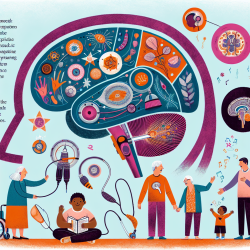Introduction
Amyotrophic lateral sclerosis (ALS) is a progressive neurodegenerative disorder affecting motor neurons, leading to muscle weakness and cognitive impairments. Recent advances in neuroimaging have provided insights into the functional alterations in brain networks associated with ALS. A groundbreaking study, "Functional alterations in large-scale resting-state networks of amyotrophic lateral sclerosis: A multi-site study across Canada and the United States," has shed light on these changes, offering valuable information for practitioners in speech-language pathology and related fields.
Understanding Resting-State Networks in ALS
Resting-state functional connectivity (Rs-FC) is a powerful tool for exploring brain network dynamics without task-based stimuli. The study utilized Rs-FC to examine intra- and inter-network connectivity in ALS patients compared to healthy controls. The findings revealed significant alterations in several resting-state networks (RSNs), including the sensorimotor, default mode, and fronto-parietal networks.
Key Findings and Implications for Practitioners
- Increased Intra-Network Connectivity: ALS patients exhibited higher intra-network Rs-FC in sensorimotor, default mode, and fronto-parietal networks. This increase was correlated with disease severity, highlighting the potential for these networks to serve as biomarkers for ALS progression.
- Inter-Network Connectivity: Enhanced connectivity between the orbitofrontal and basal ganglia networks was observed, correlating with cognitive impairments. Understanding these connections can aid in developing targeted interventions for cognitive deficits in ALS patients.
- Clinical Correlations: The study found that increased Rs-FC in specific networks was associated with clinical measures of motor and cognitive impairments. This suggests that monitoring Rs-FC changes could provide insights into the progression of ALS and the effectiveness of therapeutic interventions.
Encouraging Further Research
The study underscores the importance of continued research into the functional connectivity of brain networks in ALS. Practitioners are encouraged to consider these findings in their clinical practice and contribute to ongoing research efforts. By integrating neuroimaging data with clinical assessments, we can enhance our understanding of ALS and improve patient outcomes.
Conclusion
This study highlights the critical role of resting-state networks in understanding the pathophysiology of ALS. By leveraging these insights, practitioners can better tailor interventions to address both motor and cognitive impairments in ALS patients. For those interested in delving deeper into the research, the original study provides a comprehensive exploration of these findings.
To read the original research paper, please follow this link: Functional alterations in large-scale resting-state networks of amyotrophic lateral sclerosis: A multi-site study across Canada and the United States.










